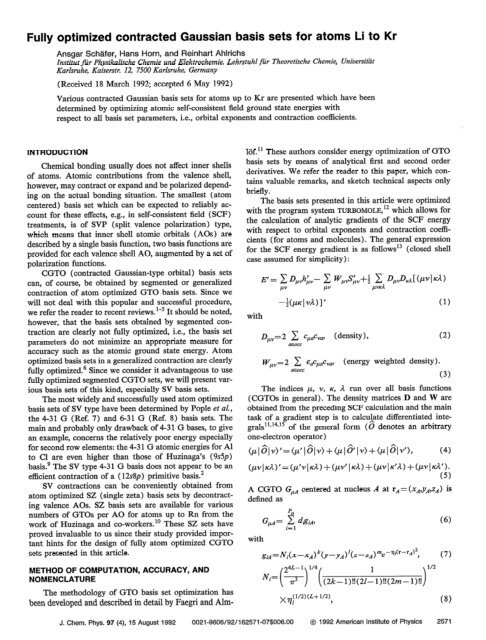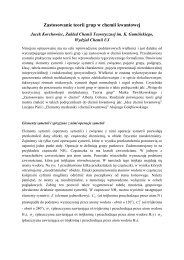Fully optimized contracted Gaussian basis sets for atoms Li to Kr
Fully optimized contracted Gaussian basis sets for atoms Li to Kr
Fully optimized contracted Gaussian basis sets for atoms Li to Kr
You also want an ePaper? Increase the reach of your titles
YUMPU automatically turns print PDFs into web optimized ePapers that Google loves.
<strong>Fully</strong> <strong>optimized</strong> <strong>contracted</strong> <strong>Gaussian</strong> <strong>basis</strong> <strong>sets</strong> <strong>for</strong> <strong>a<strong>to</strong>ms</strong> <strong>Li</strong> <strong>to</strong> <strong>Kr</strong>Ansgar Schkifer, Hans Horn, and Reinhart AhlrichsInstitut ftir Physikalische Chemie und Elektrochemie, Lehrstuhl ftir Theoretische Chemie, UniversitiitKarlsruhe, Kaiserstr. 12, 7500 Karlsruhe, Germany(Received 18 March 1992; accepted 6 May 1992)Various <strong>contracted</strong> <strong>Gaussian</strong> <strong>basis</strong> <strong>sets</strong> <strong>for</strong> <strong>a<strong>to</strong>ms</strong> up <strong>to</strong> <strong>Kr</strong> are presented which have beendetermined by optimizing a<strong>to</strong>mic self-consistent field ground state energies withrespect <strong>to</strong> all <strong>basis</strong> set parameters, i.e., orbital exponents and contraction coefficients.INTRODUCTIONChemical bonding usually does not affect inner shellsof <strong>a<strong>to</strong>ms</strong>. A<strong>to</strong>mic contributions from the valence shell,however, may contract or expand and be polarized dependingon the actual bonding situation. The smallest (a<strong>to</strong>mcentered) <strong>basis</strong> set which can be expected <strong>to</strong> reliably account<strong>for</strong> these effects, e.g., in self-consistent field (SCF)treatments, is of SVP (split valence polarization) type,which means that inner shell a<strong>to</strong>mic orbitals (AOs) aredescribed by a single <strong>basis</strong> function, two <strong>basis</strong> functions areprovided <strong>for</strong> each valence shell AO, augmented by a set ofpolarization functions.CGTO (<strong>contracted</strong> <strong>Gaussian</strong>-type orbital) <strong>basis</strong> <strong>sets</strong>can, of course, be obtained by segmented or generalizedcontraction of a<strong>to</strong>m <strong>optimized</strong> GTO <strong>basis</strong> <strong>sets</strong>. Since wewill not deal with this popular and successful procedure,we refer the reader <strong>to</strong> recent reviews. l-5 It should be noted,however, that the <strong>basis</strong> <strong>sets</strong> obtained by segmented contractionare clearly not fully <strong>optimized</strong>, i.e., the <strong>basis</strong> setparameters do not minimize an appropriate measure <strong>for</strong>accuracy such as the a<strong>to</strong>mic ground state energy. A<strong>to</strong>m<strong>optimized</strong> <strong>basis</strong> <strong>sets</strong> in a generalized contraction are clearlyfully <strong>optimized</strong>.6 Since we consider it advantageous <strong>to</strong> usefully <strong>optimized</strong> segmented CGTO <strong>sets</strong>, we will present various<strong>basis</strong> <strong>sets</strong> of this kind, especially SV <strong>basis</strong> <strong>sets</strong>.The most widely and successfully used a<strong>to</strong>m <strong>optimized</strong><strong>basis</strong> <strong>sets</strong> of SV type have been determined by Pople et al.,the 4-31 G (Ref. 7) and 6-3 1 G (Ref. 8) <strong>basis</strong> <strong>sets</strong>. Themain and probably only drawback of 4-31 G bases, <strong>to</strong> givean example, concerns the relatively poor energy especially<strong>for</strong> second row elements: the 4-3 1 G a<strong>to</strong>mic energies <strong>for</strong> Al<strong>to</strong> Cl are even higher than those of Huzinaga’s (9~5~)<strong>basis</strong>.g The SV type 4-31 G <strong>basis</strong> does not appear <strong>to</strong> be anefficient contraction of a (12&p) primitive <strong>basis</strong>.2SV contractions can be conveniently obtained froma<strong>to</strong>m <strong>optimized</strong> SZ (single zeta) <strong>basis</strong> <strong>sets</strong> by decontractingvalence AOs. SZ <strong>basis</strong> <strong>sets</strong> are available <strong>for</strong> variousnumbers of GTOs per A0 <strong>for</strong> <strong>a<strong>to</strong>ms</strong> up <strong>to</strong> Rn from thework of Huzinaga and co-workers.” These SZ <strong>sets</strong> haveproved invaluable <strong>to</strong> us since their study provided importanthints <strong>for</strong> the design of fully a<strong>to</strong>m <strong>optimized</strong> CGTO<strong>sets</strong> presented in this article.METHOD OF COMPUTATION, ACCURACY, ANDNOMENCLATUREThe methodology of GTO <strong>basis</strong> set optimization hasbeen developed and described in detail by Faegri and Alm-lbf.” These authors consider energy optimization of GTO<strong>basis</strong> <strong>sets</strong> by means of analytical first and second orderderivatives. We refer the reader <strong>to</strong> this paper, which containsvaluable remarks, and sketch technical aspects onlybriefly.The <strong>basis</strong> <strong>sets</strong> presented in this article were <strong>optimized</strong>with the program system TURBOMOLE,'~ which allows <strong>for</strong>the calculation of analytic gradients of the SCF energywith respect <strong>to</strong> orbital exponents and contraction coefficients(<strong>for</strong> <strong>a<strong>to</strong>ms</strong> and molecules). The general expression<strong>for</strong> the SCF energy gradient is as follows’3 (closed shellcase assumed <strong>for</strong> simplicity) :withE’ = 2 D,d;v - c. W&v+; p;L D,.Jh 1.W I d 1PP-&.+‘~)I’ (1)Dp,=2 c c,&, (density),a.zoccw/&v=2 c ~&lCvm (energy weighted density ) .(IEOCC(3)The indices ,u, Y, K, il run over all <strong>basis</strong> functions(CGTOs in general). The density matrices D and W areobtained from the preceding SCF calculation and the maintask of a gradient step is <strong>to</strong> calcul$e differentiated integrals’1,14~15 of the general <strong>for</strong>m ( 0 denotes an arbitraryone-electron opera<strong>to</strong>r)(~lo^lY)~=(~‘l~IY)+(yl~‘IY)+~~IOhIY~)r (4)(~u~I~/z)‘=(~‘~I~il)+(~~‘l~il)+(~~l~’il)+(~~lKil’).A CGTO GM centered at nucleus A at r, = (x~,~A,zA) isdefined asGM= .i? &a, (6)r=lwithgL4=Nz(X-XA)k(Y-YA)‘(z-z~)~e-~i(r-r~)z, (7)Nz= (22) l”( 1x77y2w+1/2),(2k-1)!!(21-1)!!(2m-l)!!) r’s(2)(5)(8)J. Chem. Phys. 97 (4), 15 August 1992 0021-9606/92/l 62571-07$006.00 @ I992 American Institute of Physics 2571
2576 Schafer, Horn, and Ahlrichs: Optimized <strong>basis</strong> <strong>sets</strong> <strong>for</strong> <strong>a<strong>to</strong>ms</strong> <strong>Li</strong> <strong>to</strong> <strong>Kr</strong>AEscF=EscF(molecule) - C Es&<strong>a<strong>to</strong>ms</strong>).The results demonstrate the quality of SVP <strong>basis</strong> <strong>sets</strong> inSCF treatments, e.g., in comparison <strong>to</strong> DZP or TZP, andconfirms the quantitative accuracy of the SCF approximationas far as structure constants are concerned. The SVP<strong>basis</strong> also shows no shortcomings with respect <strong>to</strong> SCFbinding energies <strong>for</strong> P4 or AlCls. Only <strong>for</strong> SF6 which showsa rather delicate balance of ionic (,!@+I?-) and hypervalent(3d on S) contributions <strong>to</strong> bonding, a larger <strong>basis</strong> isrequired <strong>for</strong> a quantitative account of energetics of bonding.Finally we report results <strong>for</strong> TiCl, as a transition metalcompound which can be treated on the SCF level. Theequilibrium geometry was determined with SVP and DZP<strong>basis</strong> <strong>sets</strong> [~~=0.065 (Ti), qd=0.34 (Cl)] with followingresults listed in the order SVP/DZP/exp:*’TiC&( r,)RJpm=217.3/219.5/219,AEs,&kJ mol-‘= - 1081/- 1106.Again the SVP <strong>basis</strong> shows relatively good accuracy withrespect <strong>to</strong> molecular structure and bonding energy as compared<strong>to</strong> DZP.RECOMMENDATIONSCALCULATIONSFOR WlOLECULARThe use of a<strong>to</strong>m <strong>optimized</strong> <strong>basis</strong> <strong>sets</strong> in molecular calculationsrequires some modifications and extensionswhich have been extensively discussed in the literature.‘”We only make a few comments in connection with the<strong>basis</strong> <strong>sets</strong> presented in this article.Polarization functions should be added <strong>to</strong> SV or larger<strong>basis</strong> <strong>sets</strong> <strong>to</strong> obtain a reliable account of bonding effects inSCF calculations. An SVP <strong>basis</strong> appears <strong>to</strong> yield equilibriumgeometries sufficiently close <strong>to</strong> the HF limit. Polarizationfunctions <strong>for</strong> H are here of lesser importance,5 andhydrocarbons, benzene or related compounds, andfullerenes can even be treated on the SV level.18Alkaline earth metals. Since it is absolutely necessary<strong>to</strong> have valence p functions added <strong>to</strong> the <strong>basis</strong> <strong>sets</strong> of alkalineearth elements in molecular calculations, we have <strong>optimized</strong>the corresponding SV and DZ <strong>basis</strong> <strong>sets</strong> <strong>for</strong> theexcited state 3P (i.e., ns’np’). Alternatively one can addtwo p <strong>sets</strong> <strong>to</strong> the SV <strong>basis</strong> obtained <strong>for</strong> the ground statewith exponents similar <strong>to</strong> those of the valence s functions.For boron we recommend <strong>to</strong> scale thep exponents by afac<strong>to</strong>r of 1.3, since thep contribution <strong>to</strong> molecular orbitals(MOs) is always markedly <strong>contracted</strong> as compared <strong>to</strong> the(relatively weakly bound) 2p A0 of the free a<strong>to</strong>m.SVP versus larger <strong>basis</strong> <strong>sets</strong>. If more extended <strong>basis</strong> <strong>sets</strong>than SVP are <strong>to</strong> be used, we recommend <strong>to</strong> go directly <strong>to</strong>TZP [or TZDP] <strong>for</strong> <strong>a<strong>to</strong>ms</strong> up <strong>to</strong> Ar and the DZP <strong>basis</strong> <strong>sets</strong><strong>for</strong> K <strong>to</strong> <strong>Kr</strong>. The present SV <strong>basis</strong> may be de<strong>contracted</strong> <strong>for</strong>the shell below the valence shell (by taking out the mostdiffuse function), but we have not encountered cases so farwhere this led <strong>to</strong> marked improvements. We recommend inany case that an SVP treatment <strong>for</strong> a structure determina-tion is followed by a single point calculation with a larger<strong>basis</strong> <strong>to</strong> obtain a more reliable energy-unless sufiicientexperience about the per<strong>for</strong>mance of SVP bases is alreadyavailable.Transition metal compounds show marked variationsof d occupation. To be on the safe side it is there<strong>for</strong>e recommended<strong>to</strong> contract the (5d) GTO set {3113 in a TZtype fashion. For the electron rich <strong>a<strong>to</strong>ms</strong> Ni or Cu a (4113contraction of the (6d) <strong>basis</strong> may be necessary since thisgives a better balanced description of 3dn4? vs 3d”+‘4s’(see Table II). Transition metal complexes with <strong>for</strong>maloxidation of +2 or larger <strong>for</strong> the metal a<strong>to</strong>m show onlyweak 4s and 4p occupations. In these cases one can actuallydrop the more diffuse of the two GTOs describing the 4sA0 and add a 4p set with the same exponent as the steepers GTO. In complexes with <strong>for</strong>mal charges L@ or M+l, werecommend <strong>to</strong> add two p GTO <strong>sets</strong> with exponents as <strong>for</strong>the 4s subshell <strong>to</strong> account <strong>for</strong> polarization effects or <strong>to</strong> usethe 4p functions determined by Wachters <strong>for</strong> excitedstates.i7Relativistic e&c& are already noticeable <strong>for</strong> post 3delements, so that it might be better in some cases <strong>to</strong> useeffective core potentials (ECPs) with relativistic correctionsinstead of all electron <strong>basis</strong> <strong>sets</strong>.*lSmall <strong>basis</strong> <strong>sets</strong> <strong>for</strong> methyl, -CHs, and tertiary butyl,-C(CHs),. Methyl (Me) and tertiary butyl (‘Bu) groupsare often used in preparative chemistry <strong>for</strong> steric protection.A proper description of steric requirements can beachieved by relatively small <strong>basis</strong> <strong>sets</strong> of basically SZ quality.A simultaneous optimization of <strong>basis</strong> <strong>sets</strong> and structureconstants has been per<strong>for</strong>med <strong>for</strong> methane and neopentaneas parent compounds <strong>for</strong> Me and ‘Bu. The <strong>basis</strong> <strong>sets</strong> chosen<strong>for</strong> this purpose are H: {33, C: {42/3) or {5 1 l/3 !3, wherethe larger SV <strong>basis</strong> is used only <strong>for</strong> the central carbon a<strong>to</strong>mwhich then connects these groups <strong>to</strong> the rest of the molecule.The following geometries were obtained [values inparentheses: SV <strong>basis</strong> at all <strong>a<strong>to</strong>ms</strong> ({3 13 is used as SV andDZ <strong>basis</strong> at H)/DZP <strong>basis</strong> [rl,=O.46 (H); qd=0.46 (C)/experiment]CH,:C-H= 108.3( 109.3/108.8(108.522) pm,C(CH3),:C-C= 154.3( 154.2/153.3/153.4*0.323) pm,C-H= 108.7( 109.5/109.1/l 11.4hO.8) pm,The present fully <strong>optimized</strong> minimal <strong>basis</strong> <strong>sets</strong> clearlygive a reliable description of the steric demand of thesebulky groups.CONCLUSIONFull optimization of all <strong>basis</strong> set parameters (exponentsand contraction coefficients) by means of gradienttechniques leads <strong>to</strong> <strong>basis</strong> <strong>sets</strong> of relatively small size withleast possible loss in accuracy. These <strong>basis</strong> <strong>sets</strong> are expected<strong>to</strong> be superior <strong>to</strong> those created by just contracting a<strong>to</strong>mJ. Chem. Phys., Vol. 97, No. 4, 15 August 1992
Schafer, Horn, and Ahlrichs: Optimized <strong>basis</strong> <strong>sets</strong> <strong>for</strong> <strong>a<strong>to</strong>ms</strong> <strong>Li</strong> <strong>to</strong> <strong>Kr</strong> 2577<strong>optimized</strong> GTO <strong>sets</strong>. The present fully <strong>optimized</strong> SV <strong>basis</strong><strong>sets</strong> are considered <strong>to</strong> be the best compromise of expenseand accuracy.AVAILABILITYThe <strong>basis</strong> <strong>sets</strong> presented in this article are available viaFTP (file transfer pro<strong>to</strong>col) at internet address“tchibm3.chemie.uni-karlsruhe.de” (internet number129.13.108.8) with login-ID “anonymous” in the direc<strong>to</strong>ry“/pub/<strong>basis</strong>.” Besides those mentioned in Tables I and II,the files include also <strong>basis</strong> <strong>sets</strong> of type (7,4), (8,4), (9,5),(9,5>/[5,3]/{51111/311}, (10,6), (11,7), (11,7)/[6,4]/{611111/4111), (13,9) <strong>for</strong> first row, (10,7), (11,7),(12,8), (12,9), (13,10), (13,10>/[8,6]/{61111111/5111113, (15,12), (17,12) <strong>for</strong> second row, (14,9,5) <strong>for</strong>third row transition metals, and (14,11,5), (14,11,5)/[8,6,2]/{6211111 l/61 111 l/413 <strong>for</strong> third row main groupelements.ACKNOWLEDGMENTSThis work was supported by the Volkswagen-Stiftungand by the Fonds der Chemischen Industrie.‘T. H. Dunning and P. J. Hay, in Modern Theoretical Chemistry: Methodsof Electronic Structure Theory, edited by H. F. Schaefer III (Plenum,New York, 1977), Vol. 3.‘R. Ahlrichs and P. R. Taylor, J. Chim. Phys. 78, 315 (1981).‘S. Huzinaga, Comp. Phys. Rep. 2, 279 (1985).4E. R. Davidson and D. Feller, Chem. Rev. 86, 681 (1986).‘W. J. Hehre, L. Random, P. v. R. Schleyer, and J. A. Pople, Ab initioMolecular Orbital Theory (Wiley, New York, 1986).6R. C. Raffenetti, J. Chem. Phys. 58, 4452 (1973).‘R. Ditchfield, W. J. Hehre, and J. A. Pople, J. Chem. Phys. 54, 724(1971); W. J. Hehre and W. A. Lathan, ibid. 56, 5255 (1972).s W. J. Hehre, R. Ditchfield, and J. A. Pople, J. Chem. Phys. 56, 2257(1972); M. M. Francl, W. J. Pietro, W. J. Hehre, J. S. Binkley, M. S.Gordon, D. J. DeFrees, and J. A. Pople, ibid. 77, 3654 (1982).‘S. Huzinaga, Approximate A<strong>to</strong>mic Functions I, II (Division of TheoreticalChemistry, Department of Chemistry, University of Alberta, 1971).lo <strong>Gaussian</strong> Basis Sets <strong>for</strong> Molecular Calculations, edited by S. Huzinaga(Physical Sciences Data, Elsevier, Amsterdam, 1984), Vol. 16.“K. Faegri, Jr. and J. AlmlBf, J. Comput. Chem. 7, 396 (1986).“R. Ahlrichs, M. Bar, M. Hiiser, H. Horn, and C. Kolmel, Chem. Phys.Lett. 162, 165 (1989); Recent extensions required <strong>for</strong> the optimizationof CGTOs are described in A. Schafer, diploma thesis, Karlsruhe, 1991.I3 P. Pulay, Mol. Phys. 17, 197 (1969).i4J. Almliif and P. R. Taylor, Int. J. Quantum Chem. 27, 743 (1985).15G Tonachini and H. B. Schlegel, J. Chem. Phys. 87, 514 (1987).i6F.’ B. van Duijneveldt, IBM Technical Research Report No. RJ-945,(1971).“A. J. H. Wachters, J. Chem. Phys. 52, 1033 (1970).“S Richard (private communication).I’M HIser, J. Almlof, and G. E. Scuseria, Chem. Phys. Lett. 181, 497(1991).*‘A. F. Wells, Structural Inorganic Chemistry, 5th ed. (Ox<strong>for</strong>d University,Ox<strong>for</strong>d, 1984).“P. A. Christiansen, W. C. Ermler, and K. S. Pitzer, Annu. Rev. Phys.Chem. 36, 407 (1985).**L. S. Bartell, K. Kuchitsu, and R. J. deNeui, J. Chem. Phys. 33, 1254(1960).“L. S. Bartell and W. F. Brad<strong>for</strong>d, J. Mol. Struct. 37, 113 (1977).24C. Froese Fischer, The Hartree-Fock Method <strong>for</strong> A<strong>to</strong>ms. A NumericalApproach (Wiley, New York, 1977).“E. Clementi and C. Roetti, At. Data Nucl. Data Tables 14, 177 (1974).J. Chem. Phys., Vol. 97, No. 4, 15 August 1992



